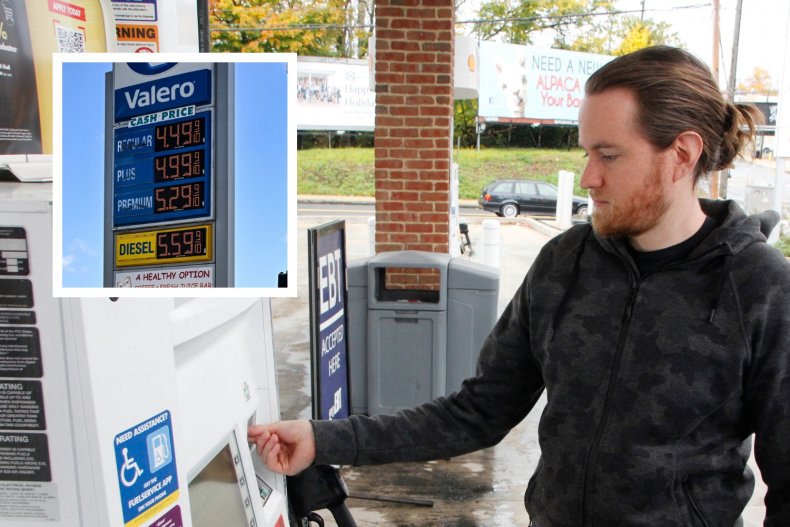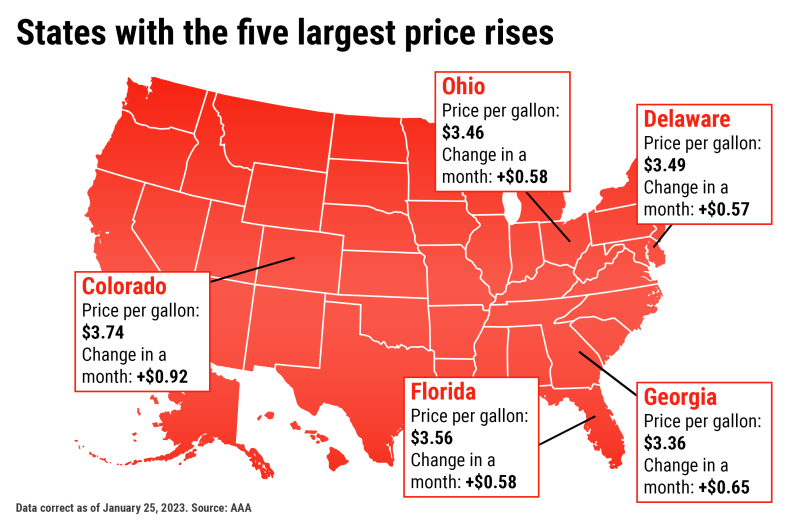Gas Prices Are Rising Fastest in These Five States
Gas prices are rising in a vast majority of the United States, with five seeing the steepest increases from a month ago. Despite an expected fall in gas prices, a mixture of supply issues and higher fuel taxes have led to the increase, experts say.
According to figures from the American Automobile Association (AAA), the national average for gas as of January 25 is $3.48 a gallon—an increase of 61 cents from a month ago. However, how much gas has risen on average from state to state varies wildly, and only three states—Oregon, Idaho and Hawaii—have seen prices fall when compared with Christmas.
After falling from a record high in 2022—a surge caused by a global oil crisis that was prompted by the war in Ukraine—gas prices across the U.S. began steadily creeping back up just before the end of the year, in part fueled by increased demand over the winter holiday.
That demand was expected to wane as seasonal travel returned to normal in January, but prices have continued to tick upwards. Devin Gladden, manager for federal affairs at the AAA, identified warmer weather after December's extreme cold snap and a rise in the price of crude oil as the key drivers of this.

"Two major trends have contributed to rising pump prices this month across the country," Gladden told Newsweek. "Milder-than-expected weather has helped to keep gasoline demand robust and the price of oil has been steadily rising above $80 per barrel."
According to the latest figures, Colorado has seen the largest upward change in gas prices for consumers. The average price at the petrol pump is $3.74 a gallon, up 92 cents from a month ago—an increase of more than 32 percent.
Gladden suggested that Suncor Energy's refinery near Denver, which produces nearly 112,000 barrels on average a day, having to shut on December 29 may be playing a role in this localized price increase. Refineries in Texas and the Gulf Coast were forced to temporarily close due to the cold snap, which drove an earlier rise in prices.
"The company said it expects to return the facility to normal operations by late in the first quarter, but the lack of a firm restart date has limited supply and boosted pump prices in the state and region," he said.

As demand remains higher than expected for the first month of the year, and refineries are still recovering from the extreme winter storm weather, leaving less supply, prices will naturally rise accordingly.
The state to see the next highest rise in average gas prices is Georgia. As of January 25, gas costs $3.36 a gallon in Georgia, up 65 cents from a month ago. Fuel suppliers and wholesalers in the state are now having to pay an excise tax of 31.2 cents a gallon for gas and 35 cents a gallon for diesel.
"After 10 months of suspension, the state resumed collecting gasoline and diesel fuel taxes about a week ago," Gladden said. "The extra boost in prices is likely due to this reason."
Ohio has seen the third sharpest increase in gas prices; now on average costing $3.46 a gallon in the state, up 58 cents from a month ago.
In September 2021, BP's refinery near Toledo, which produced 160,000 barrels daily, was forced to shut down after a fire broke out, killing two employees. Reuters reported one year later that the company had laid off most of its contractors at the site, and sources familiar with the repair work told Bloomberg it was unlikely to be completed until early 2023.
"No timeline has been set for a full restart, contributing to tighter supply and higher pump prices in the state," Gladden said.
In Delaware, gas prices have jumped up 57 cents in the past month to $3.49 a gallon on average, according to the latest figures. Gladden identified PBF's 180,000-barrels-a-day refinery in New Castle, which also had to close due to mechanical issues caused by the winter storm, as having contributed to price rises in the state.
Florida and Tennessee are the only other states to see gas prices rise more than 50 cents in a month. In Florida, gas pump prices are on average $3.56 a gallon, up 58 cents from a month ago.
Gladden noted that the excise tax on gasoline in the state had risen from 1.2 cents to 20.2 cents per gallon; for diesel, it had increased from 1.8 cents to 36.1 cents.
"Part of the reason drivers are seeing prices boosted is due to the increased price per gallon," he said.
Many other states in the south and Midwest have seen price rises from a month ago between 11 and 19 percent. Most West Coast states, California and Alaska have seen price rises in single-digit figures, amounting to less than 30 cents.

